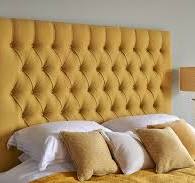Mastering the Art of Headboard Design: A Guide to Elevating Your Bedroom Decor
Exploring Headboard Design
Headboards are more than just a functional piece of furniture; they can also serve as a focal point in a bedroom’s decor. From traditional to modern, headboard designs come in a variety of styles to suit different tastes and preferences.
Traditional Elegance
For those who appreciate classic design, traditional headboards with intricate carvings and luxurious upholstery can add a touch of elegance to any bedroom. Wooden headboards with ornate details evoke a sense of timeless beauty and craftsmanship.
Modern Minimalism
If clean lines and simplicity are more your style, modern headboard designs offer sleek silhouettes and minimalist aesthetics. Metal or upholstered headboards in neutral tones can create a contemporary look that complements a modern bedroom decor.
Statement Pieces
For those looking to make a bold statement, oversized or unique headboards can become the focal point of the room. From tufted velvet headboards to geometric designs, these statement pieces can add personality and flair to any bedroom space.
Personalised Touches
Customisable headboards allow you to add a personal touch to your bedroom decor. Whether it’s choosing your favourite fabric, adding built-in storage, or incorporating LED lighting, customised headboard designs can reflect your individual style and preferences.
In conclusion, headboard design plays a significant role in shaping the overall aesthetic of a bedroom. Whether you prefer traditional elegance, modern minimalism, statement pieces, or personalised touches, there is a wide range of options available to suit every taste and style.
7 Benefits of Headboard Design: Elevate Your Bedroom’s Style and Comfort
- Enhances the aesthetic appeal of the bedroom
- Provides a focal point for the room’s decor
- Offers back support for sitting up in bed comfortably
- Helps to prevent pillows from slipping down behind the bed
- Can act as insulation against a cold wall
- Adds a layer of comfort and softness to the bed
- Allows for personalisation and customisation to reflect individual style
Six Drawbacks of Headboard Design: Space, Maintenance, Cost, Style, Installation, and Dust
- 1. Limited space
- 2. Maintenance
- 3. Cost
- 4. Style limitations
- 5. Installation challenges
- 6. Dust accumulation
Enhances the aesthetic appeal of the bedroom
Adding a headboard to a bed can significantly enhance the aesthetic appeal of the bedroom. A well-chosen headboard design can serve as a focal point in the room, tying together the decor and adding a touch of style and sophistication. Whether opting for a traditional, modern, or customised headboard, the right choice can elevate the overall look of the bedroom, creating a visually pleasing and inviting space for relaxation and rest.
Provides a focal point for the room’s decor
A key advantage of headboard design is its ability to provide a focal point for the room’s decor. By choosing a headboard that stands out in terms of style, colour, or texture, you can instantly draw attention to the bed area and create a visually appealing centrepiece in the bedroom. This focal point not only enhances the overall aesthetic of the room but also helps to anchor the design scheme and tie together different elements of the decor for a cohesive and harmonious look.
Offers back support for sitting up in bed comfortably
Headboard design offers the valuable benefit of providing back support for comfortably sitting up in bed. Whether reading a book, watching TV, or simply relaxing, a well-designed headboard can offer the necessary support to maintain a comfortable and ergonomic sitting position. This feature not only enhances the functionality of the bed but also adds to the overall comfort and convenience of the bedroom space.
Helps to prevent pillows from slipping down behind the bed
One key advantage of headboard design is its ability to prevent pillows from slipping down behind the bed. By providing a sturdy and supportive backrest, a well-designed headboard acts as a barrier that keeps pillows in place, ensuring a comfortable and neat arrangement for both aesthetic and practical purposes. This feature not only enhances the overall look of the bed but also contributes to a more comfortable sleeping experience by maintaining the pillows in their intended position throughout the night.
Can act as insulation against a cold wall
A significant advantage of headboard design is its ability to act as insulation against a cold wall. By placing a headboard behind the bed, a layer of padding can help prevent heat loss to the wall, creating a barrier that keeps the bed area warmer and more comfortable during colder seasons. This not only enhances the overall cosiness of the bedroom but also provides practical insulation that contributes to a more pleasant sleeping environment.
Adds a layer of comfort and softness to the bed
Adding a headboard to a bed design not only enhances the visual appeal of the bedroom but also brings an additional layer of comfort and softness to the sleeping experience. The padded surface of a headboard provides a cushioned support for leaning back while reading or watching TV in bed, creating a cosy and inviting atmosphere. This extra padding adds a touch of luxury to the bed, making it more comfortable for relaxation and rest, ultimately enhancing the overall comfort level of the sleeping environment.
Allows for personalisation and customisation to reflect individual style
One of the key advantages of headboard design is its ability to allow for personalisation and customisation, enabling individuals to reflect their unique style in their bedroom decor. Whether it’s selecting a specific fabric, incorporating intricate details, or opting for a bespoke design, customising a headboard provides an opportunity for individuals to create a space that truly reflects their personality and preferences. This level of personalisation not only adds a touch of individuality to the room but also ensures that the bedroom becomes a true reflection of the occupant’s style and taste.
1. Limited space
Some headboard designs can present a drawback in the form of limited space utilization, especially in smaller bedrooms. The bulkier or oversized headboards may occupy valuable space, contributing to a sense of confinement and making the room feel cramped. In such cases, opting for more streamlined or space-efficient headboard designs can help create a more open and airy atmosphere in compact bedroom settings. Careful consideration of the room’s dimensions and layout is essential to ensure that the headboard design enhances the space rather than encroaching upon it.
2. Maintenance
One drawback of headboard design, particularly upholstered headboards, is the maintenance they demand. Upholstered headboards often need frequent cleaning and upkeep to preserve their appearance and prevent the accumulation of dust and stains. This additional maintenance can be time-consuming and may require special cleaning products or professional services, adding to the overall upkeep costs of the bedroom furniture.
3. Cost
When considering headboard design, one significant drawback to keep in mind is the cost factor. High-quality headboard designs, particularly custom-made or designer options, often come with a hefty price tag. The craftsmanship and materials used in creating these bespoke pieces contribute to their elevated cost. For those on a budget, the expense of investing in a premium headboard design may pose a challenge and require careful financial planning.
4. Style limitations
One drawback of headboard design is the potential style limitations it can impose. Some headboard designs may not seamlessly match or complement changes in bedroom decor over time. This lack of versatility can restrict the flexibility to update or refresh the overall look of the bedroom without having to replace the headboard, potentially leading to a mismatched or outdated aesthetic. It is important to consider the long-term compatibility of a headboard design with evolving interior design preferences to ensure a cohesive and harmonious bedroom environment.
5. Installation challenges
When considering headboard design, one notable drawback is the potential installation challenges that may arise. Certain headboards can be heavy and cumbersome to install, making it difficult for individuals to set them up on their own. In such cases, additional help or even professional assistance might be necessary to ensure the headboard is securely and safely installed in the bedroom. This factor can add an extra layer of complexity to the process of incorporating a new headboard into the room’s decor scheme.
6. Dust accumulation
Headboards with intricate details or textures, while visually appealing, can pose a con in the form of dust accumulation. The nooks and crannies of elaborate headboard designs provide ideal hiding spots for dust particles to settle, leading to the need for more frequent cleaning maintenance. This accumulation of dust not only affects the aesthetics of the headboard but also requires extra effort to keep the bedroom environment clean and allergen-free.


